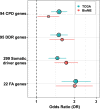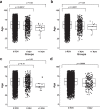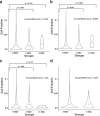Germline rare deleterious variant load alters cancer risk, age of onset and tumor characteristics
- PMID: 36707626
- PMCID: PMC9883433
- DOI: 10.1038/s41698-023-00354-3
Germline rare deleterious variant load alters cancer risk, age of onset and tumor characteristics
Abstract
Recent studies show that rare, deleterious variants (RDVs) in certain genes are critical determinants of heritable cancer risk. To more comprehensively understand RDVs, we performed the largest-to-date germline variant calling analysis in a case-control setting for a multi-cancer association study from whole-exome sequencing data of 20,789 participants, split into discovery and validation cohorts. We confirm and extend known associations between cancer risk and germline RDVs in specific gene-sets, including DNA repair (OR = 1.50; p-value = 8.30e-07; 95% CI: 1.28-1.77), cancer predisposition (OR = 1.51; p-value = 4.58e-08; 95% CI: 1.30-1.75), and somatic cancer drivers (OR = 1.46; p-value = 4.04e-06; 95% CI: 1.24-1.72). Furthermore, personal RDV load in these gene-sets associated with increased risk, younger age of onset, increased M1 macrophages in tumor and, increased tumor mutational burden in specific cancers. Our findings can be used towards identifying high-risk individuals, who can then benefit from increased surveillance, earlier screening, and treatments that exploit their tumor characteristics, improving prognosis.
© 2023. The Author(s).
Conflict of interest statement
S.G. reports consultancy and/or advisory roles for Merck and OncoMed and research funding from Bristol-Myers Squibb, Genentech, Celgene, Janssen R&D, Takeda, and Regeneron. Other authors declare no competing interests.
Figures






Similar articles
-
Inherited Rare, Deleterious Variants in ATM Increase Lung Adenocarcinoma Risk.J Thorac Oncol. 2020 Dec;15(12):1871-1879. doi: 10.1016/j.jtho.2020.08.017. Epub 2020 Aug 28. J Thorac Oncol. 2020. PMID: 32866655 Free PMC article.
-
Spectrum and prevalence of genetic predisposition in medulloblastoma: a retrospective genetic study and prospective validation in a clinical trial cohort.Lancet Oncol. 2018 Jun;19(6):785-798. doi: 10.1016/S1470-2045(18)30242-0. Epub 2018 May 9. Lancet Oncol. 2018. PMID: 29753700 Free PMC article.
-
Integrative Analysis of Germline Rare Variants in Clear and Non-Clear Cell Renal Cell Carcinoma.medRxiv [Preprint]. 2023 Jan 19:2023.01.18.23284664. doi: 10.1101/2023.01.18.23284664. medRxiv. 2023. Update in: Eur Urol Open Sci. 2024 Mar 08;62:107-122. doi: 10.1016/j.euros.2024.02.006. PMID: 36712083 Free PMC article. Updated. Preprint.
-
Germline and somatic drivers in inherited hematologic malignancies.Front Oncol. 2023 Oct 13;13:1205855. doi: 10.3389/fonc.2023.1205855. eCollection 2023. Front Oncol. 2023. PMID: 37904876 Free PMC article. Review.
-
DICER1 Tumor Predisposition.2014 Apr 24 [updated 2020 Apr 30]. In: Adam MP, Feldman J, Mirzaa GM, Pagon RA, Wallace SE, Amemiya A, editors. GeneReviews® [Internet]. Seattle (WA): University of Washington, Seattle; 1993–2025. 2014 Apr 24 [updated 2020 Apr 30]. In: Adam MP, Feldman J, Mirzaa GM, Pagon RA, Wallace SE, Amemiya A, editors. GeneReviews® [Internet]. Seattle (WA): University of Washington, Seattle; 1993–2025. PMID: 24761742 Free Books & Documents. Review.
Cited by
-
Discovering predisposing genes for hereditary breast cancer using deep learning.Brief Bioinform. 2024 May 23;25(4):bbae346. doi: 10.1093/bib/bbae346. Brief Bioinform. 2024. PMID: 39038933 Free PMC article.
-
Predisposing deleterious variants in the cancer-associated human kinases in the global populations.PLoS One. 2024 Apr 18;19(4):e0298747. doi: 10.1371/journal.pone.0298747. eCollection 2024. PLoS One. 2024. PMID: 38635549 Free PMC article.
-
Risk-reducing surgery for individuals with cancer-predisposing germline pathogenic variants and no personal cancer history: a review of current UK guidelines.Br J Cancer. 2023 Aug;129(3):383-392. doi: 10.1038/s41416-023-02296-w. Epub 2023 May 31. Br J Cancer. 2023. PMID: 37258796 Free PMC article. Review.
-
Pan-cancer proteogenomics characterization of tumor immunity.Cell. 2024 Feb 29;187(5):1255-1277.e27. doi: 10.1016/j.cell.2024.01.027. Epub 2024 Feb 14. Cell. 2024. PMID: 38359819 Free PMC article.
-
Analysis of 3760 hematologic malignancies reveals rare transcriptomic aberrations of driver genes.Genome Med. 2024 May 20;16(1):70. doi: 10.1186/s13073-024-01331-6. Genome Med. 2024. PMID: 38769532 Free PMC article.
References
-
- Robson M, Offit K. Clinical practice. Management of an inherited predisposition to breast cancer. N. Engl. J. Med. 2007;357:154–162. - PubMed
Grants and funding
- N01 HC095168/HL/NHLBI NIH HHS/United States
- R01 MH101810/MH/NIMH NIH HHS/United States
- R01 MH071681/MH/NIMH NIH HHS/United States
- N01 HC095167/HL/NHLBI NIH HHS/United States
- R01 MH090936/MH/NIMH NIH HHS/United States
- S10 OD026880/OD/NIH HHS/United States
- U01 NS053998/NS/NINDS NIH HHS/United States
- RC2 HL102924/HL/NHLBI NIH HHS/United States
- R01 CA167824/CA/NCI NIH HHS/United States
- R01 MH089025/MH/NIMH NIH HHS/United States
- UL1 TR004419/TR/NCATS NIH HHS/United States
- R01 MH101822/MH/NIMH NIH HHS/United States
- U19 CA148127/CA/NCI NIH HHS/United States
- RC2 HL102923/HL/NHLBI NIH HHS/United States
- R01 MH089208/MH/NIMH NIH HHS/United States
- N01 HC095161/HL/NHLBI NIH HHS/United States
- U54 HG003067/HG/NHGRI NIH HHS/United States
- U24 CA224319/CA/NCI NIH HHS/United States
- RC2 HL102926/HL/NHLBI NIH HHS/United States
- UL1 RR025005/RR/NCRR NIH HHS/United States
- R01 DA006227/DA/NIDA NIH HHS/United States
- R33 CA263705/CA/NCI NIH HHS/United States
- N01 HC095169/HL/NHLBI NIH HHS/United States
- R01 MH101782/MH/NIMH NIH HHS/United States
- R01 MH089004/MH/NIMH NIH HHS/United States
- R01 MH101819/MH/NIMH NIH HHS/United States
- U01 HL089897/HL/NHLBI NIH HHS/United States
- U01 DK124165/DK/NIDDK NIH HHS/United States
- P30 CA023108/CA/NCI NIH HHS/United States
- U01 HL089856/HL/NHLBI NIH HHS/United States
- U01 NS077303/NS/NINDS NIH HHS/United States
- R01 MH089175/MH/NIMH NIH HHS/United States
- N01 HC095163/HL/NHLBI NIH HHS/United States
- R01 MH090951/MH/NIMH NIH HHS/United States
- S10 OD030463/OD/NIH HHS/United States
- R01 MH101820/MH/NIMH NIH HHS/United States
- R01 MH101825/MH/NIMH NIH HHS/United States
- R01 MH090948/MH/NIMH NIH HHS/United States
- R01 MH090941/MH/NIMH NIH HHS/United States
- RC2 HL103010/HL/NHLBI NIH HHS/United States
- UL1 TR000040/TR/NCATS NIH HHS/United States
- WT_/Wellcome Trust/United Kingdom
- R01 HG005827/HG/NHGRI NIH HHS/United States
- N01 HC095162/HL/NHLBI NIH HHS/United States
- HHSN261200800001C/RC/CCR NIH HHS/United States
- R01 MH090937/MH/NIMH NIH HHS/United States
- N01 HC095165/HL/NHLBI NIH HHS/United States
- N01 HC095164/HL/NHLBI NIH HHS/United States
- HHSN261200800001E/CA/NCI NIH HHS/United States
- R01 MH101814/MH/NIMH NIH HHS/United States
- HHSN268201000029C/HL/NHLBI NIH HHS/United States
- RC2 HL102925/HL/NHLBI NIH HHS/United States
- R01 MH089482/MH/NIMH NIH HHS/United States
- N01 HC095160/HL/NHLBI NIH HHS/United States
LinkOut - more resources
Full Text Sources

